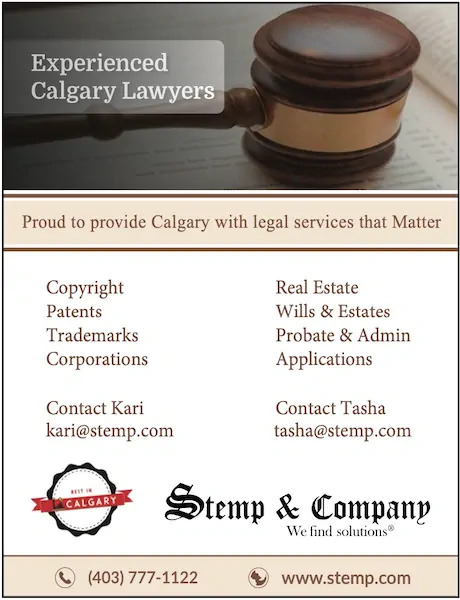INCORPORATING: SHOULD I DO IT TO PROTECT MY INVENTION?
by Bill Stemp
We are often asked by our patent and trademark clients whether it is worthwhile for them to incorporate and for their new company to hold the rights for their invention. If you, as the inventor, own the invention personally and apply for a patent in your personal name, any revenue which comes to you through commercial exploitation of the inventionor through selling your patent rights or licensing your patent rights to a manufacturer, will be taxed personally. Any such revenue will be added to whatever personal income you are making at that time and you will pay tax to Revenue Canada on the total income which you earned in that year. Therefore, the tax which you would be paying on that revenue which you are able to generate through your invention and patent would not be the percentage of tax which you now pay on your annual income, but would rather be the percentage of tax which you will be paying on the additional extra income which you enjoy as a result of your invention. This percentage of tax on your income may therefore be substantially more than what you are now paying.
However, if you incorporate a new company and have this new company hold the rights to your invention, any income enjoyed as a result of the invention will be taxed to the company. The company’s tax is not dependent on whatever income you may now be earning or may earn personally in the future or the tax which you pay on that income.
Instead, the company will pay tax to Revenue Canada based upon ITS INCOME. Of course, the corporation will pay tax based on its “net income” being the gross revenue received by the company during its fiscal year less all proper deductible expenses or costs of doing business, including depreciation on physical assets owned by the corporation. If you license the rights which you hold in your patent and trademark to a manufacturer, the manufacturer will pay any royalties or license fees to your corporation as a result of the use of your patent or the use of your trademarks by the manufacturer.
If you wish, this income can be retained by the corporation, and not paid out personally to yourself. The corporation can then take this income and use any of it which is available after paying its corporate tax for the purposes of making various investments which the corporation again would hold.
By having your personal corporation hold the patent and trademark rights, you will usually find that you have more credibility with a manufacturer or potential manufacturer if they are a distributor of your product. A manufacturer or distributor whom you may contact for the purposes of negotiating a distribution or manufacturing agreement will tend to approach you and your product much differently when that manufacturer or distributor is advised that your patent and trademark rights are held by a corporation controlled by you, rather than being controlled by you in your personal name.
If you have gone to the trouble of arranging a new company for yourself, the potential manufacturer or distributor may assume that you have a certain level of knowledge or expertise in these areas, which can only help you in your negotiations with the manufacturer or distributor.
By incorporating a company to hold your patent and trademark rights, this will also enable you to attract investors to help you in promoting the invention and sale of the product. It is usually easier for an investor to agree to invest funds into your project if the investor is receiving some type of stock interest in your product. If you have not incorporated a company, all you can offer the investors is a “piece of the action” in the product or invention. This can be secured by a written agreement between you and the investor, but this type of arrangement can be awkward or cumbersome.
Instead, if you have incorporated a company, you can offer to sell the investor a certain percentage of the shares in your company which holds the rights to the invention and any trademarks which you plan to use in promoting the sale of the product. These shares can be “preferred shares” or “common shares”. In these two classes of preferred and common shares, you can organize your company with any number of classes or series of shares.
The “classes or series” of shares would be different types of shares holding perhaps different voting rights, different rights with respect to dividends which may be payable on the shares, as well as determining whether the dividends would be payable each year as a fixed liability of the company or would a liability which the company and its directors could decide upon each year in terms of payment or accrual of the dividend to a later year.
Having a corporation also enables you to invite your investors to become advisors or “directors” of your corporation. These people have expertise and knowledge in various areas and you can use this expertise and knowledge to your benefit and to the benefit of your company, its business and to better promote your product in the marketplace. Again, having these people as directors or officers of your corporation will not only help you in obtaining financing or additional investment capital, since any lender or investor prefers to become involved in a business or company which has experienced and knowledgeable people behind it.
If you should decide to sell your company, but wish to retain ownership of the patent and trademark rights, you can do this by holding the patent and trademark rights in your own name and licensing the right to use the patent and trademarks to your company. In this case, you would personally own the patent and trademark rights, while your corporation would be allowed to use those rights. In the case of the sale of the company, the right to use the patent and trademark rights could flow to the new owner of the company, but by retaining personal ownership of the patent and trademark rights themselves, these rights would be kept by you and would not go to the new owner of the company. If you sold your company and the company previously held the right to use your patent and trademark rights but not owning those rights, you could then incorporate another company to own the patent and trademark rights and have the first company which you have now sold, pay royalties or license fees to the new company. Again, these royalties and license fees would be taxed in the hands of the new company as corporate income, rather than being taxed as personal income.
By incorporating a new company, you can also become involved in helping your children financially, through what is known as “estate planning”. This enables you to organize the affairs of your corporation to benefit your children and to lesson the tax burden in the event of your death. By issuing shares in the corporation to your children, you effectively provide them with that benefit during your lifetime, of being part owners of your company and also enabling them to assist you in promoting the company’s business and marketing your product or products. By giving up some of the ownership of the company to your children, you can better plan for the future of the company, rather than owning all the company by yourself and giving the shares in this company to your children upon your death. By incorporating a company, you can also take advantage of other tax saving measures such as “DEFERRED PROFIT SHARING PLANS” which enables you to reduce the corporation’s taxable income but not at the same time increasing your own personal tax income. Paying yourself money as a “DIVIDEND” from the corporation can also be a preferential way of pulling money out of the corporation. Deferred Profit Sharing Plans and payment of dividends are not something which you can do unless you have incorporated. One item which is often overlooked is the licensing of your trademark rights to a manufacturer. If you licensed the right to produce your product to a manufacturer, you must also make sure that you own the right to the trademark or brand name which the manufacturer is using or plans to use. It is not good enough to think that if the manufacturer wants to use its own selected name for the product, that you should allow that to happen and allow the manufacturer to win the rights to that name. If, under your license agreement, the manufacturer loses its right to manufacturer your product (for example, failing to meet a minimum annual sales quota) then you can cancel the license agreement and give the manufacturing rights to another manufacturer. In that event, you must also make sure that the rights to use the trademarks that are associated with the product, which can be brand names, letter, number, combinations of words, letters, number, etc., including logos, slogans, jingles, and graphic designs, must also be cancelled and transferred to the new manufacturer. If you are unable to do this as a result of the original manufacturer owning the “trademarks”, then the new manufacturer and yourself would be at a huge disadvantage since the public knows your product by the original brand name, not by any new name which you may have to select. As far as the public is concerned, the product appears to be new because the trademark names are new. This can cause you enormous loss. Again, the corporation which you incorporate can earn royalties and other income through licensing or allowing the use of its “TRADEMARKS”, rather than having this money paid to you personally.
As you can see from the above, there are a number of reasons why you should incorporate a new corporation to hold the rights to your product including your patent and trademark rights. This article only touches upon some of the details involved in this area. We would be pleased to meet with you at any time to discuss your inventions, products, or business ideas. We are genuinely interested and dedicated in helping you bring your product to the marketplace and in protecting the rights to your product through patents or industrial design applications, as well as protecting your trademarks and copyright interests. Please call us at any time to speak with us further.

Stemp & Company
1670, 734 – 7th Avenue SW
Calgary, Alberta T2P 3P8
Bill Stemp
403-777-1125 bill@stemp.com

























